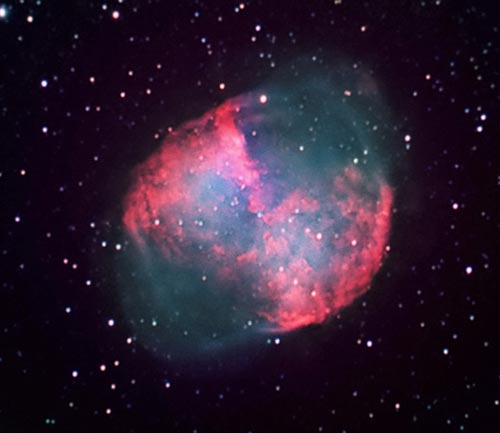Let me set the record straight. Any similarity between the nickname of a certain planetary nebula in the constellation Vulpecula and yours truly is purely coincidental.
Even though it wasn’t named for me, the Dumbbell Nebula is one of my favorite deep-sky objects. Also known by the Messier designation M27, it’s the brightest and easiest-to-observe of all planetary nebulae. Only the Ring Nebula (M57), which is smaller and fainter — but much easier to locate — attracts more attention.
Planetary nebulae are a particularly fascinating class of deep-space object. The death throes of an average-size star, like our Sun, create these cosmic puffballs. As the ailing star’s core switches from hydrogen to helium fuel, it sheds its outer layers in an expanding shell of gas. The shell’s spherical shape gives the typical planetary nebula its planet-like appearance.
Planetary nebulae fade away faster than the emission and reflection nebulae that give birth to stars. While the latter survive for millions of years, a planetary nebula’s gases dissipate into the blackness of interstellar space after a few thousand years.
Finding M27 can be a challenge even for the experienced skygazer. Its parent constellation, Vulpecula the Fox, contains no bright naked-eye stars. To find M27, trace a line from Gamma (γ) Lyrae through Beta (β) Cygni, and then extend it an equal distance beyond.
Or, if you can find the constellation Sagitta, you can take a more direct route to M27 by aiming toward Gamma Sagittae and then moving about 3° northward. Under a dark sky, binoculars and finder scopes will pick up M27 as a small smudge of light close to the star 14 Vulpeculae. A low-power eyepiece can sweep up M27 because of the nebula’s relatively large size (8′ by 5′) and brightness (magnitude 7.3). Once you’ve found it, switch to higher power. The Dumbbell is a remarkable sight at magnifications of 100x or more.
Any planetary nebula’s central star can be a challenge to see because it’s a faint white dwarf immersed in nebulosity. I’ve glimpsed M27’s central star in my 13-inch using a moderately high magnification (175x), and I suspect it can be viewed with an 8-inch scope under favorable conditions. If you have trouble seeing the central star, try averted vision. Here’s a trick to see faint stars and nebulous detail: Concentrate your gaze to the side of your target. The light then falls on a more sensitive part of the retina, revealing detail not normally visible with a direct view.
What I find most fascinating about the Dumbbell is the 3-D illusion it presents when viewed through a telescope. The Dumbbell seems to hover in the foreground against the backdrop of Milky Way stars.
If you’ve never seen M27, put it on your observing list for the next clear, moonless night. If you’ve already notched it with your telescope, don’t assume a “been there, done that” attitude. Like a fine painting, M27 shows something new each time you study it. This dumbbell will be giving the Dumbbell Nebula some serious attention during the months ahead. Why not join me?
Questions or comments? E-mail me here. Next month: a look at the “Demon Star.” Clear skies!











